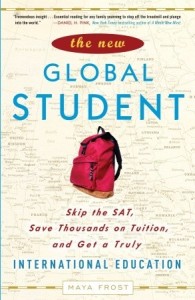The New Global Student: Book Review
The New Global Student: Skip the SAT, Save Thousands on Tuition, and Get a Truly International Education by Maya Frost
My rating: 3 of 5 stars
As an avid and frequent traveler, and one who has set out on many independent research adventures abroad, I felt The New Global Student was a must read. While the writing style and layout was highly distracting, this book is filled with some worthwhile content and advice. Here are my assessments of the general strengths and weaknesses of the book, as well as my final takeaways.
Strengths:
As a fellow traveler, I admire Frost and her bold move to take her four teenage daughters abroad to give them unique experiences that ultimately led to positive outcomes. I love this family travel model, and I also appreciate her focus on learning and not just achievement, which is a problem I see in the traditional education system. I agree with her when she says we should be “helping our kids learn to deal with uncertainty” instead of “sheltering” them (7). This move towards self-directed learning is positive and something I would like to see more of, both in traditional classrooms and in study abroad programs, because I believe student engagement is at the heart of lasting and meaningful learning. Travel can be a catalyst in this process.
Another point I agree with in this book is the importance of learning a language, which is not emphasized enough in traditional education. Frost says often schools teach language “in the name of “global education” (24), but these courses do not adequately prepare students to actually speak the language. They can even become meaningless, because often employers seek people who learned outside of the classroom (33). Immersing students in a host culture is a great way to help students authentically learn a language in a way they can use it in their futures.
Chapter seven, “How to Save Thousands on College Study Abroad,” seemed most relevant to me and my experiences. I’m all for ditching the expensive “packaged study abroad programs” (24) promoted by universities in place of independent field studies or direct enrollments which allow students to bypass the middle man. By skipping out on this “cruise mentality” (181), students are able to absorb more of the culture, do more of the heavy lifting, engage in their learning, and reflect more deeply. It also helps when there are not dozens of other college students with them, sheltering their experience as they walk around in a giant comfort bubble. This sort of travel does not stand out to future employers or drastically change a student’s trajectory. As Frost put it, “Indie” students “know that they can duplicate the services included in most study abroad packages for a fraction of the cost” (207). Plus, we should be involving students in their own education if we want them to get excited about it (119). I agree, and I wish everyone knew one doesn’t have to fork up thousands of dollars to study internationally in college.
Unique travel experiences, I have found, do equip students with useful tools, “critical skills” (89), and set them apart from other applicants. Frost backs this up with plenty of case studies of global students. As one of Frost’s exemplar students says, “studying abroad was more than experiencing a new culture. It helped me learn about my own capabilities and strengths” (128). For me, my independent travel experiences and directed readings courses in college gave me leadership and research qualifications that few of my friends who did traditional study abroad programs enjoyed. I feel it was my travel experiences in college that landed me a job right out of college with Teach For America and a free Master’s Degree from a reputable university. Some people mistakenly assume travel is a waste of time or a sign of an uncommitted mind, but I found it helped me launch ahead in my career, similar to Frost’s daughters.
In addition to more self-directed learning, I am all for inquiry-based programs. Frost dropped lots of practical options for individuals from IB, CSA, Rotary, and various online organizations which provide resources for students looking to transition abroad. These lists are one of the greatest assets to the book.
Weakness and Wonderings:
One aspect about the book that I did not agree with was an assumption that students are dropping out of high school because they are just bored or freaked out by college. I have worked in urban schools and I can assure you that the reasons the majority of kids are dropping out of school has little to do with Frost’s thesis. There are many people who are not privileged enough to quit everything and live abroad the way the Frost family did because they lack the opportunities and resources. Encouraging kids to drop out, with the assumption that they all have the skills necessary to succeed in a community college, is not a stance I agree with. I still believe schools are tasked with ensuring students have the basic skills they need to be successful in college, and skipping this step should not be taken lightly. Not everyone has “an enormous amount of freedom to choose from a tantalizing smorgasbord of education options” (19). Also not every student can study abroad instead of “getting some pathetic summer job” (214), because many people actually need that job to get by.
Another concern I find with Frost’s premise is found on the very first pages of the book. She states that there will be “no angst about competing with others” (xv) under this new approach, but I disagree. I think at the heart of her argument is the assumption that her model is superior. I recognize Frost has to sell her parent audience on the benefits of her international educational model, but I get the sense that Frost does feel her approach is wildly better than what the rest of people are doing. Skipping the SAT is a low bar for measuring whether or not students are competing for college and the future job market. It’s unavoidable, which is a main reason why Frost gave her daughters this unique opportunity—to make them competitive applicants.
I also challenge Frost when she says that “the advantages of sending kids abroad during college pale in comparison to the advantages of sending kids abroad at a younger and more malleable age” (171). While this is her personal experience, I feel there is far too much emphasis on high school travel over the college ages, when students are more qualified and (hopefully) more mature later. I do not see any significant benefit to making this transition before college as opposed to later and appreciate the value of both.
Even if I put my concerns about students not developing academic skills aside, I think many students may be better off in high school given their age and cognitive development. Frost continually brings up “missing prom” as the only real reason to regret not attending traditional high school, ignoring the value of the traditional model. Developmentally, not all high school students may be ready to jump into a foreign country or start college. I’m also put off by Frost’s disdain for AP classes. At their core, AP classes are more rigorous courses for students to prepare for college, even if universities no longer accept them for credit. Frost seems hyper concerned about credits at the expense of important content.
Final Thoughts:
I think Frost is onto something, despite the questions I have about some of her arguments. I firmly believe meaningful travel experiences prepare students for the future in ways a typical classroom cannot. We cannot look to the traditional education model to solve our problems or prepare us for life after college the way we could have decades ago. We must also look outside.
However, travel is not a substitute for a foundational education, nor do I think it replaces the importance of content often learned in a classroom. By all means, do what you can to engage students through learner-owned education and self-directed learning because they will ultimately take the wheel and run with it, but at the same time do not assume you can drop any struggling student in Kenya and expect her to come back ready to enter college at the age of 15.
With all that said, I am grateful for another needed voice about the tangible benefits of pursuing an international education. For me it has been the most transformative education I’ve ever received.
View all my reviews

















